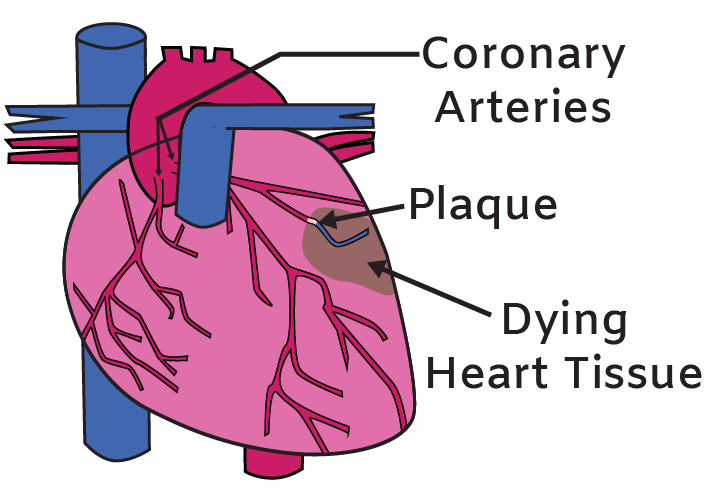What is a Heart Attack? Heart Attack Causes & Prevention Tips
Learn More About Simplified Science PublishingA heart attack is an injury to heart tissue that results in low oxygen levels. The most common cause of a heart attack is a blood vessel blockage related to heart disease.
One in four people die of heart disease each year in the USA. This is a shocking statistic that may increase your heart rate when you think about the high probability that you or someone you know will have a life-threatening experience with their heart.
One of the most common deadly events is a heart attack. A heart attack occurs when a lack of oxygen results in the death of heart tissue. (When you think of heart attack, think of oxygen lack). Like all of your internal tissues, heart muscles need oxygen from the bloodstream and when oxygenated blood is prevented from reaching a section of the heart, the muscle cells begin to die. The death of cardiac muscle can prevent the heart from pumping properly and leads to symptoms such as shortness of breath and discomfort in a person’s chest and upper body.
What causes a heart attack?
Most heart attacks are caused by blockage of a blood vessel that supplies oxygenated blood to the heart’s muscle tissue. These blood vessel blocks can be caused by plaques that plug one of the heart’s oxygen-supply blood vessels, called coronary arteries. But heart attacks can also occur if a muscle spasm narrows a blood vessel and reduces blood flow.
Depending on the person and the severity of the blood flow blockage, a heart attack can have mild to severe symptoms. To improve the odds of surviving a heart attack, it is essential that a person act fast and dial 911 at the first sign of symptoms. Heart attack symptoms can include chest or upper body discomfort and pains, shortness of breath, dizziness, and nausea.
Without immediate treatment to remove the blood vessel plaque or to relax the spasm, the lack of oxygen results in damage to cardiac muscle tissue and can cause a person to die within a half hour of the first symptoms. If a person survives a heart attack, the injured artery or muscle tissue may develop a permanent scar that negatively affects the blood pump’s function for the remainder of the person’s life. Nearly one million people in the United States have a heart attack each year and many people die because they do not get help fast enough.
How can you prevent heart attacks and improve outcomes?
The prospect of heart-disease can be overwhelming but there are many things that you can do to help prevent heart attacks. The best thing that you can do for better heart health is to move! It doesn’t need to be strenuous exercise—take a walk with a friend and stand up and stretch for a few minutes numerous times throughout each day. You should also reduce the amount of high-fat foods in your diet to prevent an accumulation of fatty deposit plaques in your blood vessels.
And even if you are healthy, you should be aware of common heart attack symptoms and how they can present differently in men and women. If you are feeling any chest pain or difficulty breathing, don't hesitate to call for medical care at the first sign of symptoms.
Altogether, the heart is at the center of your body’s health and well-being and it is one of the easiest organs to appreciate. Take good care of your heart with exercise and a healthy diet and pay attentions to any changes in your heart beat pattern. Please also consider donating to help fund lifesaving research and advocate for better heart health for at-risk populations.
Related Content:
- How Does the Heart Work? Review Heart Structure and Function
- How Do Arteries and Veins Work? Blood Vessel Structure and Function
- What is Blood Made Of? Review Blood Components and Functions
- How Does the Diaphragm Work? Diaphragm Structure and Function
- How Do Lungs Work? Lung Structure and Function
- What is Aerobic Respiration and Why is it Important?
References:
- Harrison's Principles of Internal Medicine, 18th Edition. Longo DL, Fauci AS, Kasper DL, Hauser SL, Jameson J, Loscalzo J. eds.
- Anatomy, Physiology, and Disease: An Interactive Journey for Health Professions , 2nd Edition. Bruce J. Colbert, University of Pittsburgh, Johnstown.
- https://www.nhlbi.nih.gov/health-topics/heart-attack
Create professional science figures with illustration services or use the online courses and templates to quickly learn how to make your own designs.
Interested in free design templates and training?
Explore scientific illustration templates and courses by creating a Simplified Science Publishing Log In. Whether you are new to data visualization design or have some experience, these resources will improve your ability to use both basic and advanced design tools.
Interested in reading more articles on scientific design? Learn more below:
Content is protected by Copyright license. Website visitors are welcome to share images and articles, however they must include the Simplified Science Publishing URL source link when shared. Thank you!




